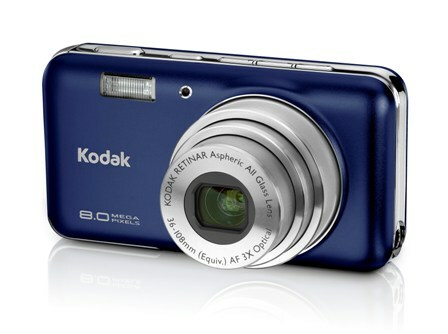Kodak Easyshare V803 review
Golden Dream, Mystic Purple, Cosmic Blue. A New Age revival? No, they’re three of the eight colours available for Kodak’s new pocket cam

For years we’ve been seeing cameras pour out of the Far East in myriad shades only to find that by the time they’ve reached our shores the choice has been cut down to black or silver.
So Kodak, bless it, has decided to put things right. Its 8MP V803 comes in eight, count ‘em, eight shades of lacquer from gold to purple. And, yes iPod fans, it comes in white too. If you want brown or graphite you’ll have to go for the 10MP V1003 version which comes in, you guessed it, ten hues.
The camera’s part of Kodak’s Pocket line-up that includes the easy-as-pie slim shooter, the V603, and the innovative dual-lens, 10x zooming, V610. This one’s put on a few pounds from both those cams, opting for a rounded, chunky monkey look that’s pleasing enough on the eye but not as pocketable as its other chums in the range.
The front is a fuss-free, plain wash of colour, bar the flash and the 3x zoom lens which remains silver whichever shade you opt for. Round the back the sleek look breaks down a bit with a recessed 2.5in screen in between two silver blocks bestrewn with buttons.
Here comes trouble
We perhaps had an inkling that we wouldn’t get along with this Kodak when we had trouble turning it on. Here’s a rough transcript: Push power button, nothing happens. Check battery, push power button again, more firmly this time, note cheap plasticky feel, but still nothing happens. Push and HOLD power button – lens shoots out and camera springs to life.
Not that this is a fast camera. Compared to Canon’s Ixus 75 with its Digic III processor it is big and slow. Start-up time is woeful. It took us four seconds to turn the camera on and take a properly focussed shot, compared to one second with the Ixus. That could make all the difference between papping Posh Spice and watching her new blond ‘do disappear unprofitably into the distance.
Control freak
Controls are spread out confusingly over two sides of the camera and feel flimsy, especially the tiny four-way direction stick. It’s difficult to use one-handed, especially as there’s no grip to speak of. It’s slow to focus and, with no face recognition, doesn’t always hit the right spot.
When it finally does focus, the results are actually pretty good. Colours are (typically for Kodak) well saturated and detail is razor-sharp. Exposure is generally spot-on and it’s easily adjusted up or down by moving the direction controller left or right before taking the shot.
Sadly the same can’t be true of indoor snaps. The flash is weak and as the ISO creeps above 200 the shots get progressively more noisy and less detailed. There is an anti-blur mode but all it does is whack up the ISO even higher to the point where the results are pretty much unusable. The onboard Kodak Perfect Touch software will rescue some dark shots and is great to have in-camera, but it can’t work miracles.
Video performance is good and the zoom works while your film – shame that it makes a noise like a power drill as it churns through its range.
Bottom line is that you can get good results with this camera in the right light and with enough patience but, given that it such a pig to use, why would you want to bother?
Not that this is a fast camera. Compared to Canon’s Ixus 75 with its Digic III processor it is big and slow. Start-up time is woeful. It took us four seconds to turn the camera on and take a properly focussed shot, compared to one second with the Ixus. That could make all the difference between papping Posh Spice and watching her new blond ‘do disappear unprofitably into the distance.
Control freak
Controls are spread out confusingly over two sides of the camera and feel flimsy, especially the tiny four-way direction stick. It’s difficult to use one-handed, especially as there’s no grip to speak of. It’s slow to focus and, with no face recognition, doesn’t always hit the right spot.
When it finally does focus, the results are actually pretty good. Colours are (typically for Kodak) well saturated and detail is razor-sharp. Exposure is generally spot-on and it’s easily adjusted up or down by moving the direction controller left or right before taking the shot.
[MPU]
Sadly the same can’t be true of indoor snaps. The flash is weak and as the ISO creeps above 200 the shots get progressively more noisy and less detailed. There is an anti-blur mode but all it does is whack up the ISO even higher to the point where the results are pretty much unusable. The onboard Kodak Perfect Touch software will rescue some dark shots and is great to have in-camera, but it can’t work miracles.
Video performance is good and the zoom works while your film – shame that it makes a noise like a power drill as it churns through its range.
Bottom line is that you can get good results with this camera in the right light and with enough patience but, given that it such a pig to use, why would you want to bother?



